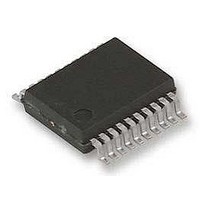ATA5743P6-TKQY 19 Atmel, ATA5743P6-TKQY 19 Datasheet - Page 12

ATA5743P6-TKQY 19
Manufacturer Part Number
ATA5743P6-TKQY 19
Description
RF Receiver UHF ASK / FSK Receiver
Manufacturer
Atmel
Type
Receiverr
Datasheet
1.ATA5743P3-TGQY.pdf
(43 pages)
Specifications of ATA5743P6-TKQY 19
Package / Case
SSO-20
Operating Frequency
449 MHz
Operating Supply Voltage
4.5 V to 5.5 V
Maximum Operating Temperature
+ 105 C
Minimum Operating Temperature
- 40 C
Mounting Style
SMD/SMT
Noise Figure
7 dB
Lead Free Status / RoHS Status
Lead free / RoHS Compliant
6.2
6.3
12
Polling Mode
Sleep Mode
ATA5743
As shown in
three different modes. In sleep mode, the signal processing circuitry is disabled for the time
period T
nal processing circuits are enabled and settled. In the following bit-check mode, the incoming
data stream is analyzed bit-by-bit, looking for a valid transmitter signal. If no valid signal is
present, the receiver is set back to sleep mode after the period T
check-by-check as it is a statistical process. An average value for T
cal characteristics. During T
condition of the receiver is indicated on pin IC_ACTIVE.
The average current consumption in polling mode is dependent on the duty cycle of the active
mode and can be calculated as:
During T
reception of a transmitted command, the transmitter must start the telegram with an adequate
preburst. The required length of the preburst depends on the polling parameters T
T
on the actual bit rate and the number of bits (N
The following formula indicates how to calculate the preburst length.
T
The length of period T
sion factor X
be:
T
In US and European applications, the maximum value of T
to “1”; the time resolution is about 2 ms in that case. The sleep time can be extended to almost
half a second by setting X
As seen in
permanent sleep condition. The receiver remains in that condition until another value for Sleep is
programmed into the OPMODE register. This function is desirable where several devices share
a single data line and may also be used for microcontroller polling – via pin POLLING/_ON, the
receiver can be switched on and off.
I
Spoll
Bit-check
Preburst
Sleep
= Sleep
=
, and the start-up time of a connected microcontroller (T
Sleep
I
--------------------------------------------------------------------------------------------------------------- -
Sleep
Soff
T
Sleep
Table 6-7 on page
Figure 6-2 on page
Sleep
while consuming low current of I
and T
T
+ T
T
X
Sleep
Sleep
(see
Sleep
Startup
Startup
Sleep
+
+
Table 6-8 on page
I
Son
T
, the receiver is not sensitive to a transmitter signal. To guarantee the
+ T
1024
Sleep
Startup
is defined by the 5-bit word Sleep of the OPMODE register, the exten-
Bit-check
Startup
to 8. X
T
26, the highest register value of sleep sets the receiver into a
13, the receiver’s polling mode consists of a continuous cycle of
+
Startup
T
Clk
T
+ T
Bit-check
and T
Sleep
Start_
+
T
can be set to 8 by setting bit X
26), and the basic clock cycle T
Bit-check
µ
Bit-check
C
S
Bit-check
= I
Soff
, the current consumption is I
. During the start-up period, T
) to be tested.
Sleep
Start,
is about 60 ms if X
Bit-check
µ
Bit-check
C
). Thus, T
SleepStd
is given in the electri-
Clk
. This period varies
. It is calculated to
to “1”.
Bit-check
4839B–RKE–08/05
S
Startup
Sleep
= I
Sleep
depends
Son
, T
, all sig-
Startup
. The
is set
,














